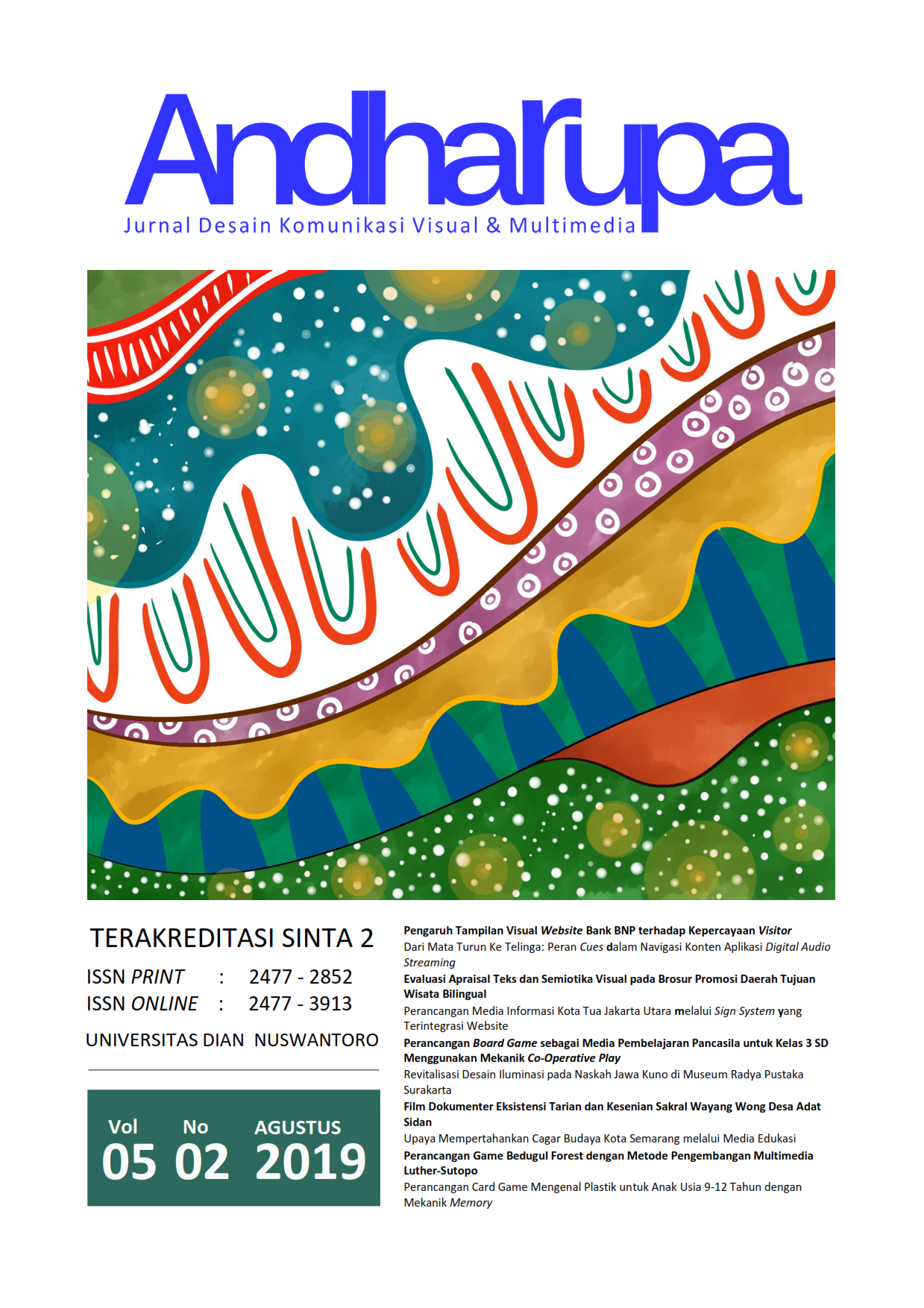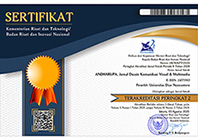DARI MATA TURUN KE TELINGA: PERAN CUES DALAM NAVIGASI KONTEN APLIKASI DIGITAL AUDIO STREAMING
DOI:
https://doi.org/10.33633/andharupa.v5i2.2484Abstract
AbstrakPara pengguna ponsel pintar (smartphone users) sudah terbiasa menggunakan aplikasi mobile yang dipasangkan pada perangkat mereka. User mencari konten yang mereka inginkan dengan cara mengandalkan aspek visual yang disajikan oleh suatu aplikasi mobile. Aspek visual juga berlaku untuk menavigasi diri user dalam aplikasi yang menyediakan konten audio seperti aplikasi digital audio streaming. User mengandalkan aspek visual berupa cues pada Social Information Processing Theory (SIPT). Verbal cues antara lain nama penyanyi, judul lagu, nama playlist, lalu non-verbal cues seperti artwork yang menyertai sebuah konten lagu. Dengan mengambil contoh aplikasi Spotify, peneliti ingin menunjukkan bahwa aspek visual merupakan aspek utama dalam navigasi aplikasi konten audio. Penelitian dilakukan dengan analisis konten kualitatif untuk menelaah cues SIPT yang terdapat pada aspek navigability dalam model MAIN, diperkuat dengan focus group discussion kepada user Spotify untuk mendapatkan data mengenai pengalaman navigasi konten musik lewat cues yang tersedia. Analisis dilakukan dengan metode kualitatif deskriptif untuk menunjukkan aspek-aspek cues yang dominan. Hasil penelitian menunjukkan fitur search paling banyak digunakan untuk mencari konten lagu yang diinginkan dan user menavigasi pencarian terutama lewat judul lagu. Kata Kunci: aplikasi mobile, cues, digital audio streaming, navigasi, visual AbstractSmartphone users have accustomed to using mobile applications – apps – on their phones, either pre-installed or obtained through the app market. Users look for any content they desire in an app by relying on visual aspects presented by the app itself. These visual aspects also relied on when users need to navigate themselves through audio content made available in digital audio streaming apps. These aspects in the framework of Social Information Processing Theory (SIPT) in terms of verbal cues are artists’ names, song titles, playlists’ names, and non-verbal cues are artworks that accompany audio contents. Taking Spotify as a sample case, writers want to show that visuals become the sole aspect to navigate through content in a digital audio streaming app. The writers use qualitative content analysis to study elements of SIPT cues in the MAIN model. A focus group discussion to Spotify users is also conducted to obtain data about their navigating experience through cues available in the app. The analysis was conducted qualitative-descriptively to show which dominant aspects of cues. Results show ‘search’ as the most used feature when navigating through Spotify, and song title becomes the most popular way to search for songs.  Keywords: cues, digital audio streaming, mobile app, navigation, visualReferences
Balogun, M. O., & John-Akinola, Y. O. (2015). A Qualitative Study of Intimate Partner Violence Among Women in Nigeria. Journal of Interpersonal Violence, 30(14), 2410–2427. https://doi.org/10.1177/0886260514553112
Burgers, C., Eden, A., de Jong, R., & Buningh, S. (2016). Rousing reviews and instigative images: The impact of online reviews and visual design characteristics on app downloads. Mobile Media and Communication, 4(3), 327–346. https://doi.org/10.1177/2050157916639348
Elo, S., Kääriäinen, M., Kanste, O., Pölkki, T., Utriainen, K., & Kyngäs, H. (2014). Qualitative Content Analysis: A Focus on Trustworthiness. Sage Open, (January-March 2014), 1–10. https://doi.org/10.1016/S1479-3709(07)11003-7
Eriksson, M., Fleischer, R., Johansson, A., Snickars, P., & Vonderau, P. (2019). Spotify Teardown. London: MIT Press.
Griffin, E., Ledbetter, A., & Sparks, G. (2019). A First Look at Communication Theory. (E. Griffin, A. Ledbetter, & G. Sparks, Eds.) (10th ed.). New York: McGraw-Hill Education.
Herbert, D., Lotz, A. D., & Marshall, L. (2018). Approaching media industries comparatively: A case study of streaming. International Journal of Cultural Studies, 1–18. https://doi.org/10.1177/1367877918813245
Hsieh, H. F., & Shannon, S. E. (2005). Three approaches to qualitative content analysis. Qualitative Health Research, 15(9), 1277–1288. https://doi.org/10.1177/1049732305276687
Iqbal, M. (2019). Spotify Usage and Revenue Statistics (2019). Retrieved May 22, 2019, from http://www.businessofapps.com/data/spotify-statistics/
Jansson, J., & Hracs, B. J. (2018). Conceptualizing curation in the age of abundance: The case of recorded music. Environment and Planning A, 50(8), 1602–1625. https://doi.org/10.1177/0308518X18777497
Lobato, R. (2018). Rethinking International TV Flows Research in the Age of Netflix. Television and New Media, 19(3), 241–256. https://doi.org/10.1177/1527476417708245
Macgregor, S. K. (2005). Hypermedia Navigation Profiles: Cognitive Characteristics and Information Processing Strategies. Journal of Educational Computing Research, 20(2), 189–206. https://doi.org/10.2190/1mec-c0w6-111h-yq6a
McKelvey, F., & Hunt, R. (2019). Discoverability: Toward a Definition of Content Discovery Through Platforms. Social Media + Society, 5(1), 205630511881918. https://doi.org/10.1177/2056305118819188
Morris, J. W. (2015). Curation by code: Infomediaries and the data mining of taste. European Journal of Cultural Studies, 18(4–5), 446–463. https://doi.org/10.1177/1367549415577387
Mulligan, M. (2018). From Ownership to Access. Retrieved March 26, 2019, from http://www.midiaresearch.com/blog/from-ownership-to-access/
Potter, W. J., & Levine-Donnerstein, D. (1999). Rethinking Validity and Reliability in Content Analysis.
Rothwell, E., Anderson, R., & Botkin, J. R. (2016). Deliberative Discussion Focus Groups. Qualitative Health Research, 26(6), 734–740. https://doi.org/10.1177/1049732315591150
Spotify. (2019). Shareholder Letter Q4 2018, 1–13.
Straubhaar, J., LaRose, R., & Davenport, L. (2012). Media Now: Understanding Media, Culture, and Technology(2011)-1. Michael Rosenberg.
Sundar, S. S. (2008). The MAIN model: A heuristic approach to understanding technology effects on credibility. Digital Media, Youth, and Credibility, 73–100. https://doi.org/10.1162/dmal.9780262562324.073
Tausch, A. P., & Menold, N. (2016). Methodological Aspects of Focus Groups in Health Research: Results of Qualitative Interviews With Focus Group Moderators. Global Qualitative Nursing Research, 3. https://doi.org/10.1177/2333393616630466
Downloads
Published
Issue
Section
License
Copyright (c) 2019 ANDHARUPA: Jurnal Desain Komunikasi Visual & Multimedia

This work is licensed under a Creative Commons Attribution 4.0 International License.
Authors who publish with this journal agree to the following terms:
- Authors retain copyright and grant the journal right of first publication with the work simultaneously licensed under a Creative Commons Attribution License that allows others to share the work with an acknowledgment of the work's authorship and initial publication in this journal.
- Authors are able to enter into separate, additional contractual arrangements for the non-exclusive distribution of the journal's published version of the work (e.g., post it to an institutional repository or publish it in a book), with an acknowledgment of its initial publication in this journal.
- Authors are permitted and encouraged to post their work online (e.g., in institutional repositories or on their website) prior to and during the submission process, as it can lead to productive exchanges, as well as earlier and greater citation of published work (See The Effect of Open Access).















